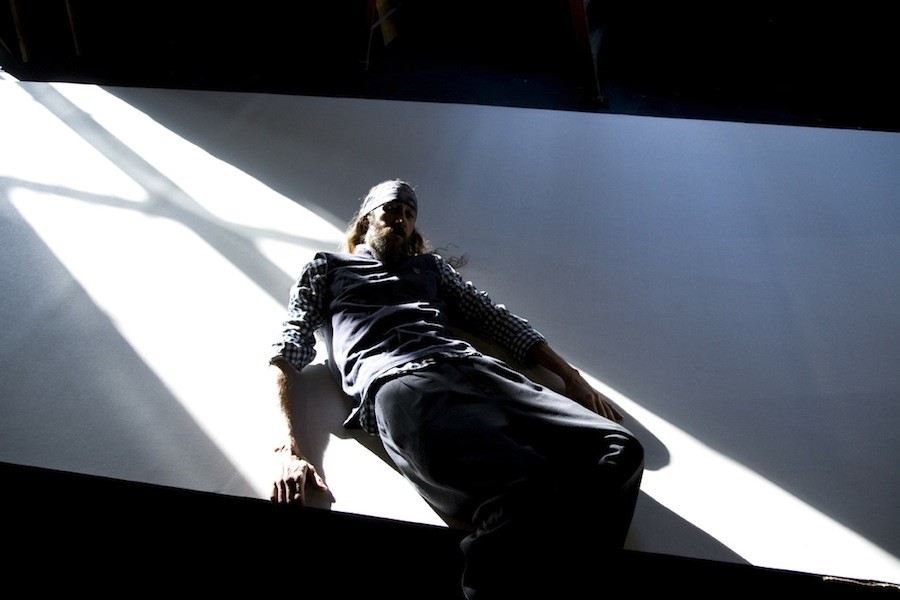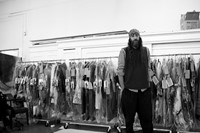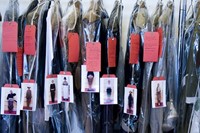To coincide with Miguel Adrover's highly anticipated return to New York fashion week later today, the designer speaks to New York Minute columnist Derek Peck and exclusively reveals his new collection...
Late one afternoon in November I was walking along my street in the Lower East Side when I bumped into Miguel Adrover, the influential fashion designer who left New York in 2004. It was the first time I’d seen him in several years and he looked upbeat, excited even. He’d just gotten to town that day, he said, and he was happy to be back in his old neighbourhood where he had lived and worked for many years. After a moment, he leaned in and said, “I’m coming back. I’m showing in New York again.”
This was big news from the man who electrified the New York fashion world at the end of the 1990s, and it’s been carefully guarded until just this week. Tonight, Miguel will show his first collection in New York City in nearly eight years, returning to the Lower East Side theater where he started it all with his now-legendary Manaus-Chiapas-NYC collection.
"Miguel truly exemplified the spirit of the city at the dawn of a new century"
During the late ‘90s and early 2000s, Miguel Adrover was one of my favorite New Yorkers. He truly exemplified the spirit of the city at the dawn of a new century. An immigrant from Spain, he made Manhattan his home and embraced it so completely and exuberantly that, through his work, he was able to give ordinary New Yorkers a heightened awareness of what a unique and special place they inhabited. Often, he would wax poetic about the city in the most surprisingly original and insightful ways.
Whitman-like, no one seemed to better get New York’s dynamic energy, its crosscurrents of culture, its major themes – even its place in a globalising world – and turn it into art, commentary, and theater. Of course, Adrover is a fashion designer; he makes clothes. But somehow, at a certain moment in time everything came together and transcended mere garments on bodies, partly because the garments themselves were so transcendent, telling stories of street and style, politics and class, life and survival. There was something almost novelistic about a Miguel Adrover runway show that could stir your soul – a rare day in fashion. If McQueen was fashion’s visionary, Adrover was its bard.
His return, now, is sure to create some fresh excitement. But there will be those, too, who wonder why.
Although widely considered to be the most important New York designer of that period, he left the city something of a fallen hero, having failed to sustain his business. His rise was meteoric but his fall came quickly. It was one of the more interesting story arcs in fashion in the last decade. It’s been covered at length, so I won’t go into it here, but it all hinged on three main things. Bad attitude: Adrover’s work celebrated fashion but also fiercely critiqued the industry, and some people took offense to both his artistic and public statements. Bad timing: His Utopia collection, which continued an exploration of Middle Eastern themes, showed just two days before 9/11, resulting in mumblings of "Taliban" and “terrorist” fashion, stigmatising Adrover in Patriot-Act America as a pariah. Bad business: His deal with Pegasus was suspect. They were an unproven entity in the apparel world and when the economy slipped following 9/11 they went south and took Adrover with them. Even though he made acclaimed comebacks on his own, he never regained the support of the fashion establishment, who wanted a reliable, sellable brand.
"This new collection will again test the preconceptions of the fashion world"
This new collection will again test the preconceptions of the fashion world. Composed almost entirely of repurposed clothes from his own wardrobe, Adrover has not cut or sewn a single garment, nor has he used a single pattern or bolt of fabric. He wants to show that beautiful clothing can be made without relying upon convention, and can be done from what we have available. He says he got the inspiration after returning from trips to Egypt and then Cuba, where, he says, “It makes you see how lucky and unlucky we are.”
“I came home and looked at my closet and nearly cried. I said to myself, I am not going to do this any more. I felt like, fashion is no longer interesting. I don’t get excited anymore. I don’t want to add to a system of making inauthentic things, where anybody can get anything, anywhere, anytime. I want to re-excite myself, to find a way to express myself again, that is meaningful and sustainable and respects the changes I see going on in the world. I decided to repurpose my clothes, to make something new from them.”
“One thought I had was, what if a plane is flying over the Amazon and all the luggage of all the people falls out and lands in the jungle near a village? What would they do with the clothes? How would they put them together? This helped me conceive what I wanted to do.”
Here, Adrover veers more toward art than the commerce of fashion, which has always been both the brilliance and the challenge of his work. Naturally, from the business side this begs a question. If there are no patterns, how can the collection be produced for retail? “I don’t intend for this collection to be produced,” he says. I am not looking for clients. With this one, my only goal is to make myself happy.”
“I came home and looked at my closet and nearly cried. I said to myself, I am not going to do this any more. I felt like, fashion is no longer interesting"
Some may think that he’s playing a joke, thumbing his nose at the fashion world yet again. Possibly even completing the circle with a big F.U. And who knows.... Not having to be concerned about sales and production, he’s free to lean more fully into his tendency toward provocation.
But Adrover has his own way of explaining things: “I think I am returning to something I did in some ways in the beginning yet I have grown and have had time to think a little. I have been designing a commercial collection for hessnatur for five years now. And this collection evolved from wanting to share what I was feeling using clothing. I locked myself away in some respects and just let it all out of my head. It was not completely intentional “not to sell” but it was not what I was thinking about for sure when I made this. It was purely an artistic expression. And a statement in a way against convention and luxury. I am here to share my experience. I am here because I got my energy from this city from the beginning. This city allowed me to express my point of view and I want to drop that energy back again. I want to get people excited about being fearless in your thoughts, about letting your creativity go without thinking about what it would cost or who will buy it.”
With signature Adrover wit, this show is titled “Out of my Mind”. Plenty of people will say he is, for having the audacity to come back and send an entirely un-commercial collection down the runway. But, as always with Adrover, the meaning is more layered than this. He also means that he’s out of his mind with fashion as commodity, out of his mind with the way it’s marketed, the environmental impact of it, and so on....
Of course, these are the kind of statements that got him into trouble before. But he seems less concerned about that now, with his position as creative director at Hessnatur and their support in making this collection.
Whether his autumn/winter 2012, Out of my Mind collection is applauded or dismissed, received with appreciation or offense, Miguel Adrover remains one of the deepest, most profound thinkers in fashion, who also makes gorgeous clothes, and it’s exciting to have him designing again.
However it all plays out, I’d just like to say one thing: Welcome Home, Miguel. We’ve missed you.


